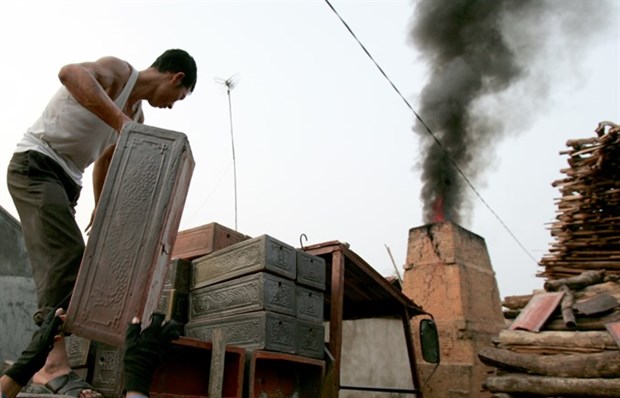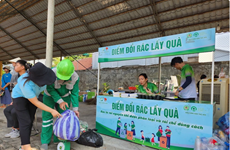Vietnam’s craft villages harm the environment
Some 5,000 craft villages across the country have been seriously polluting the environment and threatening the health of residents in surrounding areas.
 Smoke from ceramics kilns in Phu Lang Pottery Village. (Photo: VNA)
Smoke from ceramics kilns in Phu Lang Pottery Village. (Photo: VNA)Hanoi (VNA) - Some 5,000 craft villages across the country have been
seriously polluting the environment and threatening the health of residents in
surrounding areas.
According to data issued by the Ministry of Natural Resources and Environment, only 4.1 percent of craft villages use wastewater treatment systems.
In Hanoi alone, 1,350 craft villages discharge up to 156,000 cubic metres of wastewater directly into the environment each day.
For example, four craft villages of Duong Lieu, Cat Que, Minh Khai, and Son Dong in Hoai Duc district were found to be releasing about 8,200 cubic metres of wastewater into the environment daily.
Nguyen Thi Hien, a resident living in Duong Lieu commune said she and other residents had to suffer bad smells from craft villages’ wastewater, especially during hot weather.
“It’s terrible,” she said.
Some craft villages processing farm produce in the districts of Thanh Oai and Bac Tu Liem also discharge about 7,000 cubic metres of wastewater per day.
In Hai Duong province - home to 66 craft villages, wastewater produced by the Phu Loc wine craft village and the Tong Buong rice-paper craft village was pumped directly into the province’s canals.
As a result, statistics from the provincial Natural Resources and Environment Department showed that the concentration of Chemical Oxygen Demand (COD) - the amount of oxygen needed in water, was 12-15 times higher than permitted, the concentration of total suspended solids (TSS) was 2-3 times higher than permitted, and the concentration of ammonia was 12-16 times higher than permitted.
Ngo Duy Hieu, deputy head of Hanoi’s National Assembly delegation, said authorised agencies have failed to deal with violations related to craft village pollution. Therefore, they were partly blamed for the ongoing problems.
Poor cooperation between local residents and authorised agencies in discovering and handling violations also exacerbated the situation, he said.
Additionally, funds for reversing the pollution as well as raising awareness among village workers of the protection of water resources were still limited, he added.
In the short-term, Hanoi has piloted a model to build centralised wastewater treatment systems in craft villages in districts of Chuong My, Hoai Duc and Quoc Oai.
Tran Thi Phuong Hoa, chairwoman of Hanoi Women’s Union said city administration should conduct assessments of the effectiveness of this model.
It was also advised to make a list of craft villages that were heavy polluters, and then allocate funds to fix the problem soon, she said.
Nguyen Ngoc Thuan, Vice Chairman of the People’s Committee of Gia Lam district, where Bat Trang Craft Village is located, suggested authorised agencies strengthen punishments to bring the situation under control.
In the long-term, Hanoi’s administration has approved a project, worth 1.35 trillion VND (59.4 million USD) in an attempt to end pollution caused by 1,350 craft villages in the city by 2030.
In the meantime, Hai Duong administration has consulted experts and relevant agencies to come up with solutions.
Senior water expert Dao Trong Tu said at first authorities should focus on educating people about the importance of water resources.
“So that public awareness of water resources protection will be improved soon,” he said.
Tu also asked policymakers to issue policies that encourage private enterprises to invest in wastewater treatment systems as a potential solution for the situation.-VNA
According to data issued by the Ministry of Natural Resources and Environment, only 4.1 percent of craft villages use wastewater treatment systems.
In Hanoi alone, 1,350 craft villages discharge up to 156,000 cubic metres of wastewater directly into the environment each day.
For example, four craft villages of Duong Lieu, Cat Que, Minh Khai, and Son Dong in Hoai Duc district were found to be releasing about 8,200 cubic metres of wastewater into the environment daily.
Nguyen Thi Hien, a resident living in Duong Lieu commune said she and other residents had to suffer bad smells from craft villages’ wastewater, especially during hot weather.
“It’s terrible,” she said.
Some craft villages processing farm produce in the districts of Thanh Oai and Bac Tu Liem also discharge about 7,000 cubic metres of wastewater per day.
In Hai Duong province - home to 66 craft villages, wastewater produced by the Phu Loc wine craft village and the Tong Buong rice-paper craft village was pumped directly into the province’s canals.
As a result, statistics from the provincial Natural Resources and Environment Department showed that the concentration of Chemical Oxygen Demand (COD) - the amount of oxygen needed in water, was 12-15 times higher than permitted, the concentration of total suspended solids (TSS) was 2-3 times higher than permitted, and the concentration of ammonia was 12-16 times higher than permitted.
Ngo Duy Hieu, deputy head of Hanoi’s National Assembly delegation, said authorised agencies have failed to deal with violations related to craft village pollution. Therefore, they were partly blamed for the ongoing problems.
Poor cooperation between local residents and authorised agencies in discovering and handling violations also exacerbated the situation, he said.
Additionally, funds for reversing the pollution as well as raising awareness among village workers of the protection of water resources were still limited, he added.
In the short-term, Hanoi has piloted a model to build centralised wastewater treatment systems in craft villages in districts of Chuong My, Hoai Duc and Quoc Oai.
Tran Thi Phuong Hoa, chairwoman of Hanoi Women’s Union said city administration should conduct assessments of the effectiveness of this model.
It was also advised to make a list of craft villages that were heavy polluters, and then allocate funds to fix the problem soon, she said.
Nguyen Ngoc Thuan, Vice Chairman of the People’s Committee of Gia Lam district, where Bat Trang Craft Village is located, suggested authorised agencies strengthen punishments to bring the situation under control.
In the long-term, Hanoi’s administration has approved a project, worth 1.35 trillion VND (59.4 million USD) in an attempt to end pollution caused by 1,350 craft villages in the city by 2030.
In the meantime, Hai Duong administration has consulted experts and relevant agencies to come up with solutions.
Senior water expert Dao Trong Tu said at first authorities should focus on educating people about the importance of water resources.
“So that public awareness of water resources protection will be improved soon,” he said.
Tu also asked policymakers to issue policies that encourage private enterprises to invest in wastewater treatment systems as a potential solution for the situation.-VNA













